Results
News
Dominique Reynié,
Helen Levy
-

Available versions :
EN
Dominique Reynié
Helen Levy
The first round
I.- The results of the first round (9 June)
(in % of votes cast)
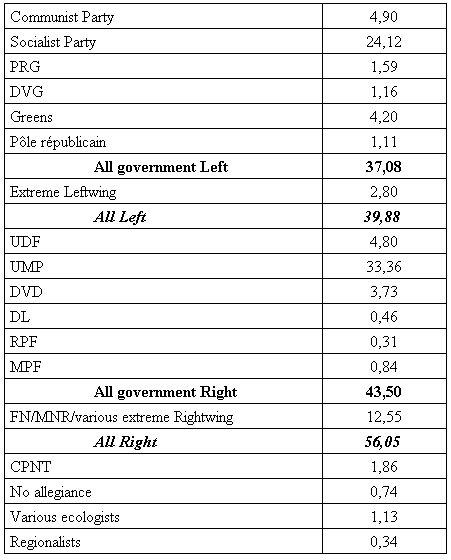
II.- UN RECORD D'ABSTENTION (35,6%)
The abstentionist trend continued. Since the first round of the presidential election the abstention rate continued to rise. We heard or read that the abstention rate was strongest when the general elections came immediately after a presidential election. This is true. And yet caution is necessary when an explanation appears to transform a type of behaviour into a law of political science that finds its foundation in two suppositions only. It is an understatement to say that it is impossible to see any kind of developing trend. In 1981 and 1988 the election and re-election of François Mitterrand as President of the Republic led to dissolution. Let us take a closer look at these two events. In April 1981 abstention during the first round of the presidential elections was at 18.3%, whilst abstention from the first round of the general elections in June when up to 29.1%. In 1988, abstention from the first round of the presidential election was at 17.9%, and reached 33.9% during the first round of the general election in June. In 2002, abstention during the first round of the presidential election was at 28.4%. It reached 35,6% during the first round of the general elections. These three past events would seem to strengthen the theory we spoke of above. But two things must be said, first of all we can see that in similar circumstances the abstention rate during the first round of the general elections after a presidential election increased significantly between 1981 and 2002. In the first instance it was at 29.1% and rose to 35.6% in the second instance. Secondly if we take the abstention rate during the general elections that did not follow a presidential election we have to admit that the upward trend remains the same: 21.5% in 1986 (a single round due to proportional representation), 30.7% in 1993 and 31.5% in 1997.
Between 1958 and 1978, the average abstention rate lay at around 21.41%. Between 1981 and 2002, it reached 32.88%. Overall during the V Republic the average abstention rate during the first round of the general elections is at 26.6% (except in 1986). There is therefore a strong trend towards abstention that cannot be explained simply by general elections following those for the president.
Abstention during the first round from 1958 to 2002
(general elections - mainland- in %)
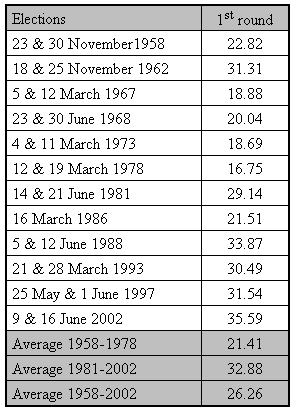
III.- AN EXCESSIVE OFFER OF CANDIDATES.
If we look at the general elections that have taken place during the V Republic we can see an increase in the number of candidates. This phenomenon might be interpreted as a new opportunity in the electoral competition, a decline of the major established parties or even the effects of the legislation about the financing of political activity. It is certain that the 2002 crop owes much to the 1988 law. But when we look at the previous lists of candidates, although the laws on financing explain the rise in the number of candidates since 1993, an upward trend had already started previous to the 1988 law.
The list of candidates since 1958
(general elections - mainland – 1st round)
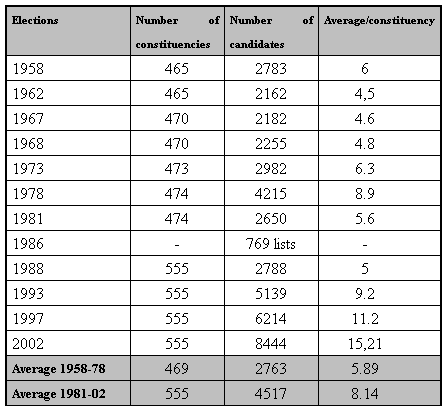
IV.- THE ERRATIC DEVELOPMENT OF THE SECOND VOTE.
The development of the second vote is not as clear. Overall during this period it is difficult to pinpoint a real upward trend. The 1968 and 1981 elections distinguish themselves by the high number of seats taken in the first round. Although these two elections are typified by landslide victories, by the Right in 1968 and the Left in 1981, the same goes for the 1993 elections with victory for the Right, whereas the percentage of constituencies undergoing a second vote was one of the highest during the V Republic. However since 1981 and the 1986 elections apart due to a specific type of vote, a regular rise in the number of victories made a second vote necessary. The fight for the general elections seems to be increasing in ferocity, which is in line with the growing influence of the penalty vote in preference of a second vote. Finally it should be noted that the percentage of constituencies involved in a second vote reached a peak during the 1997 elections. This was especially due to the increase in competition on the right and the "triangular" effect, when the National Front candidates were retained for the second round. The 2002 elections bear witness to a decline in the number of constituencies involved in a second vote (50,1%, ie 90% of mainland constituencies), ie a comparable or closer level to the one reached in 1958 (91.61%), in 1973 (90%), in 1978 (88%) and in 1993 (87%).
The second round since 1958
(general elections - mainland - 1st round)
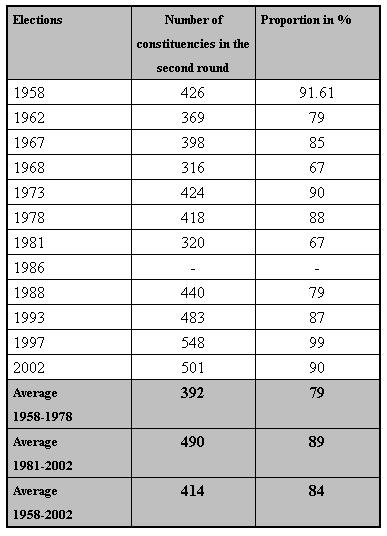
V.- THE EXPANSION OF ELECTORAL DISSIDENCE (55.8%)
Since 1958, abstention from the general elections has followed a sinuous path and has reached different proportions depending on whether it was during a first or second round. However since 1981 we can really speak of a trend towards abstention. Some elections certainly rally more than others. Hence the hope or fear of change might explain the historically low level of abstention during the 1978 general elections (16.75%). However since 1981, although the general elections were alternate, the abstention level has continued to increase. This cancels out the idea of an "election to rally voters" on the one hand, and confirms the major part played by abstentionists over the last twenty years in the unfurling of electoral confrontation on the other.
Abstaining from an election whether it is out of spite, indifference, strategy or conviction indicates the relationship that people have with electoral policy. The same applies to the level of blank votes in so far as voters approve the electoral procedure by taking time to go and vote but refuse the electoral list, thereby refusing to accept the choice they are offered. It is also possible to add abstentions and blank votes to the vote in favour of political movements of protest, such as the extreme right or left, or even the support granted to "community" candidates such as the "hunters". It is possible to group together the types of behaviour that are revealed by abstention, blank, protest or community votes, without ignoring the subtleties that separate them, into what we might call "electoral dissidence".
The weight of « electoral dissidence » from 1958 to 2002
(general elections - mainland - 1st round - in %)

Between 1958 and 1973, the influence of electoral dissidence has developed unequally alternating between highs and lows on a perfectly regular basis. However from 1978 onwards each of the general elections ended in a rise reaching a "majority" level in 1997 (52.47%), that was confirmed and superseded in 2002 (55.8%). Electoral dissidence comprises an undeniably new phenomenon in the history of the French general election. Never before have so many indicators converged to express discontent with the electoral offer either one way or another. It even brings the electoral convention into question.
VI.- POWER STRUGGLE : THE REVERSAL OF THE 1997 RESULTS
During the first round of the elections in 1997, the government left/right ratio favoured the left by 6.5 points: 42.3% for the government left (total left without the extreme left) and 35.8% for the government right (total right without the extreme right). The total of all rightwing groups including the extreme right (15.2%) maintained the electoral body on the right however (51%). During the first round on 9 June 2002 the struggle for government power was reversed. With 43.5% of the votes cast, the government right was ahead of the government left by 6.42 points (37.08%), ie the preceding difference but in the opposite direction.
a)an electorate that clearly went over to the right (56.05%).
However if we add the extreme Right score (FN+MNR+Various extreme right = 12.55%) to the total right we see that the electoral body is clearly over on the right in 2002, reaching 56.05%, against 51% in 1997; whilst the total left went from 44.5% in 1997 to 39,88% in 2002. In 1997, the left/right difference stood at 6.5 points, in favour of the right. In 2002, the difference is 16.17 points, still in favour of the right. The left/right difference has increased therefore by nearly 10 points in favour of the right.
b)the left/right ratio between 1958 and 2002.
The electoral power struggle between left and right is a traditional indicator in French political life. Its development within the context of the general elections of the V Republic reveal the fundamental domination of the French rightwing in votes. In 11 elections the left has only been in the majority twice in numbers of votes (1978 and 1981). Likewise although the left/right difference varies greatly in points from one election to another, the greatest difference (18.42 points) was in favour of the right (1968). The weakest difference in votes (1 point) was also in favour of the right whereas it translates into a victory for the left in numbers of seats (1988). Likewise we see that the right was defeated in the 1997 elections in spite of a left/right ratio which was in favour of the latter (by 5 points), (1 point in favour of the right). Finally we see that the difference between the left/right tended to decrease during the V Republic. From 1958 to 1978, the average difference was 10 points whilst between 1981 and 1997, the average difference was 3.29 points. From this point of view the general elections in June 2002 demonstrate a very positive difference in favour of the right once again. (16.17 points).
The Development of the Left/Right relationship since 1958
(general elections – mainland - 1st round- in % of votes cast)
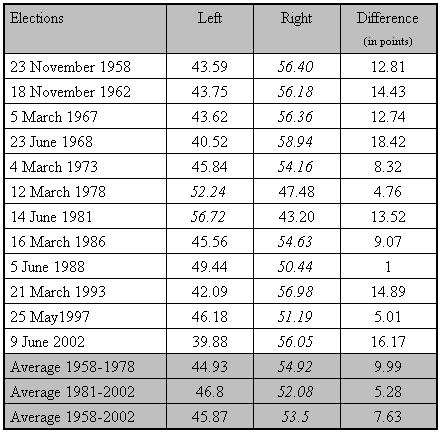 Total Left/Right is not equal to 100%, a small part of the vote being granted to groups that do not fit into this ranking.
Total Left/Right is not equal to 100%, a small part of the vote being granted to groups that do not fit into this ranking.
VII.- RIGHT AND LEFT : THE ADVENT OF AN IMPERFECT PARTISANSHIP
The 2002 general elections were heavily influenced by a new layout in the institutional game and by the partisan re-organisation of the democratic right. The new institutional layout was the fruit of the government's cohabitation crisis. The changeover to the five-year term of office and the reversal of the electoral calendar aimed to make it difficult to return to a competitive dyarchy in the leadership. The electorate that was not really in favour of cohabitation understood perfectly the consequences of these changes. The partisan re-organisation on the right in the form of the Union for the Presidential Union (UMP), was in line with the logic of this new context. The UMP and the PS took advantage of a return to the "useful vote" after a decade of electoral dissipation.
a) The UMP's triumph (33.36%).
On the right the comparison of the scores with 1997 is difficult and deceptive given the absorption of the RPR and part of the UDF by the UMP, and especially after the division of the DL. However if we look at previous results we can see the electoral results produced by the new partisan offer. During the first round of the 1997 elections the RPR totalled 16.5% of the votes cast, coming out almost equal with the UDF (14.9%). On 9 June 2002, the UMP rallied 33.36% of the vote against 4,8% for the UDF. Finally we can see that the RPR/UDF total that represented 31.4% of the vote in 1997 rallies 38.1% of the votes cast in 2002 in the form of the UDF/UMP ie an advance of 6.7 points.
b) The Socialist Party puts up a good fight (24,12%).
The defeat of the plural left was spectacular, especially because of the failure of those representing it (Martine Aubry, Robert Hue, Dominique Voynet and Jean-Pierre Chevènement). However the decline of the Socialist Party is limited. IN 1997 it rallied 25.7% of the votes cast. In 2002 it maintained 24.12%. The plural left's defeat is therefore not that of the PS.
c) The rise of the useful vote (57,48%).
The triumph of the useful vote is one of the main events of the first round. We can see in this a result of the presidential election on 21 April: on both the left and the right the extreme dispersion of the vote had a disastrous effect that most of the French did not want to see again. In 1997 the total votes for the RPR, UDF and the PS represented 57.1%. In 2002, the UMP and the PS rallied the same number of votes in all (57.48%).
d) the defeat of secondary parties.
Mechanically the triumph in favour of the PS and the UMP was achieved to the detriment of the other political movements. Such is the case on the left. The extreme left won 2.8% of the votes cast, representing an increase in comparison with 1997 (2.2%), but a collapse in comparison with 21 April (10.42%). Likewise the Greens improved their 1997 score (3.7%) to reach 4.2%, but a decline in comparison with 21 April (5,24%). The Communist Party lost 5 points, dropping from 9,9% of the votes cast in 1997 to 4,9% in 2002. Its score has been divided by four since 1981 (16.1%).
Such is the situation on the right. The UDF is a victim of its own independent strategy for the time being. It declined by 10 points between the two first rounds, going from 14.9% in 1997 to 4.8% in 2002. The extreme right suffered an electoral reversal in 2002. With 12.55%, it has a long way to go before it reaches its 1997 score (15.2%), ie a decline of 3 points bringing the extreme right back to its 1993 level (12.7%). We should remember that this is a total of the FN/MNR/Various extreme right. In 1997, the FN stood alone whilst in 2002 it was competing with the MNR. In 2002 the level reached by the FN alone was 11.2%.
e)The political failure of the extreme right.
The electoral failure of the extreme right reveals itself to be a political failure, the FN and MNR candidates did not manage to go through into the second round. The number of three-cornered contests including an FN candidate went from 14 in 1993 to 76 in 1997 and down to 9 in 2002. Likewise the number of duals with a leftwing candidate facing an FN representative went from 5 in 1993 to 25 in 1997 and then 8 in 2002. The extreme right's ability to disrupt has become a marginal one, for the time being.
THE SECOND ROUND
I.-A RECORD LEVEL OF ABSTENTION DURING THE SECOND ROUND (39.33%)
It was a question of whether the abstention rate during the second round would supersede that of the first. Again the improvised theory led us to believe that the second round was always more favourable in terms of participation than the first. If we take a look at the history of the general elections since 1958, we can see that abstention during the second round was lower than the first in six instances: 1962, 1973, 1978, 1981, 1988 and 1997. On the contrary in 1958, 1967, 1968 and 1993, the abstention rate was greater during the second round, ie in four instances, to which we must now add June 2002, since the abstention rate increased by four points between rounds.
Abstention during the second round between 1958 to 2002
(general elections - mainland - in %)
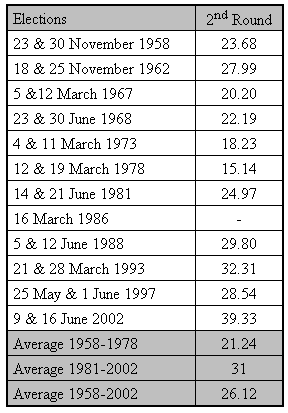
II.- THE GOVERNMENT RIGHT CLAIMS THE MAJORITY (52.86%)
General Elections. Second round results
(in % of votes cast)
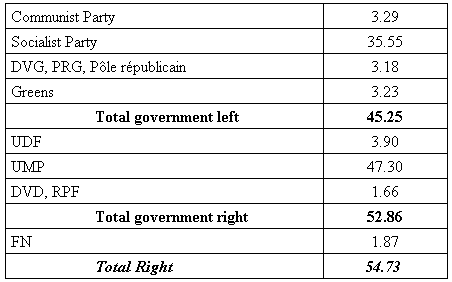
III.- PERMANENCE OF THE PENALTY VOTE
The results of the general elections during the V Republic reveal two major periods: from 1958 to 1978, voters re-elected systematically the out-going Rightwing majority. The re-election vote dominates. At each of the six general elections during this first period the out-going majority was re-elected with a greater or lesser margin. This period that distinguishes itself by Rightwing domination came to an end after the general elections in 1978. At the end of an unfavourable first round the out-going majority finally just managed to avoid defeat. The situation that enabled the majority to remain in power in 1978 was a precursor for the second period. From 1981 to 2002 the out-going majority alternately left and right was invariably beaten. The Right was beaten in 1981, 1988 and 1997. The Left was beaten in 1986, 1993 and 2002. The development of the general election results during the V Republic reveals a deep rooted change in the electoral behaviour of the French and the defeat of the out-going majorities is only the most obvious indicator. The return to the "re-election vote" would not appear to be a sensible objective for those in power.
On the same theme
To go further
Elections in Europe
Corinne Deloy
—
15 April 2025
Elections in Europe
Corinne Deloy
—
25 February 2025
Elections in Europe
Corinne Deloy
—
18 February 2025
Elections in Europe
Corinne Deloy
—
28 January 2025

The Letter
Schuman
European news of the week
Unique in its genre, with its 200,000 subscribers and its editions in 6 languages (French, English, German, Spanish, Polish and Ukrainian), it has brought to you, for 15 years, a summary of European news, more needed now than ever
Versions :



